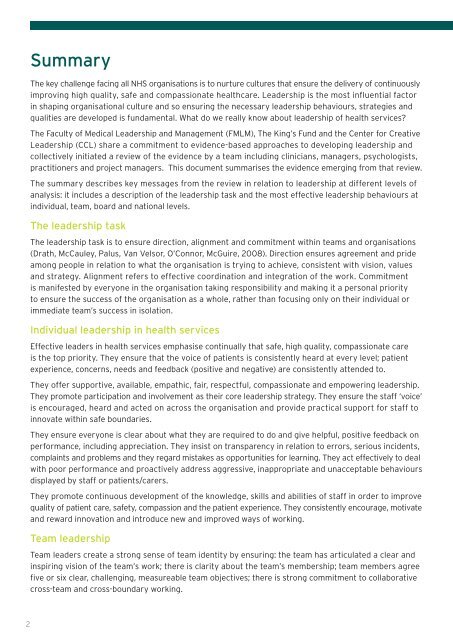leadership-leadership-development-health-care-feb-2015.pdf?dm_i=21A8,37JJV,FLXBMP,BHQ9G,1&utm_content=buffer668ab&utm_medium=social&utm_source=twitter
leadership-leadership-development-health-care-feb-2015.pdf?dm_i=21A8,37JJV,FLXBMP,BHQ9G,1&utm_content=buffer668ab&utm_medium=social&utm_source=twitter
leadership-leadership-development-health-care-feb-2015.pdf?dm_i=21A8,37JJV,FLXBMP,BHQ9G,1&utm_content=buffer668ab&utm_medium=social&utm_source=twitter
You also want an ePaper? Increase the reach of your titles
YUMPU automatically turns print PDFs into web optimized ePapers that Google loves.
Summary<br />
The key challenge facing all NHS organisations is to nurture cultures that ensure the delivery of continuously<br />
improving high quality, safe and compassionate <strong>health</strong><strong>care</strong>. Leadership is the most influential factor<br />
in shaping organisational culture and so ensuring the necessary <strong>leadership</strong> behaviours, strategies and<br />
qualities are developed is fundamental. What do we really know about <strong>leadership</strong> of <strong>health</strong> services?<br />
The Faculty of Medical Leadership and Management (FMLM), The King’s Fund and the Center for Creative<br />
Leadership (CCL) share a commitment to evidence-based approaches to developing <strong>leadership</strong> and<br />
collectively initiated a review of the evidence by a team including clinicians, managers, psychologists,<br />
practitioners and project managers. This document summarises the evidence emerging from that review.<br />
The summary describes key messages from the review in relation to <strong>leadership</strong> at different levels of<br />
analysis: it includes a description of the <strong>leadership</strong> task and the most effective <strong>leadership</strong> behaviours at<br />
individual, team, board and national levels.<br />
The <strong>leadership</strong> task<br />
The <strong>leadership</strong> task is to ensure direction, alignment and commitment within teams and organisations<br />
(Drath, McCauley, Palus, Van Velsor, O’Connor, McGuire, 2008). Direction ensures agreement and pride<br />
among people in relation to what the organisation is trying to achieve, consistent with vision, values<br />
and strategy. Alignment refers to effective coordination and integration of the work. Commitment<br />
is manifested by everyone in the organisation taking responsibility and making it a personal priority<br />
to ensure the success of the organisation as a whole, rather than focusing only on their individual or<br />
immediate team’s success in isolation.<br />
Individual <strong>leadership</strong> in <strong>health</strong> services<br />
Effective leaders in <strong>health</strong> services emphasise continually that safe, high quality, compassionate <strong>care</strong><br />
is the top priority. They ensure that the voice of patients is consistently heard at every level; patient<br />
experience, concerns, needs and feedback (positive and negative) are consistently attended to.<br />
They offer supportive, available, empathic, fair, respectful, compassionate and empowering <strong>leadership</strong>.<br />
They promote participation and involvement as their core <strong>leadership</strong> strategy. They ensure the staff ‘voice’<br />
is encouraged, heard and acted on across the organisation and provide practical support for staff to<br />
innovate within safe boundaries.<br />
They ensure everyone is clear about what they are required to do and give helpful, positive feedback on<br />
performance, including appreciation. They insist on transparency in relation to errors, serious incidents,<br />
complaints and problems and they regard mistakes as opportunities for learning. They act effectively to deal<br />
with poor performance and proactively address aggressive, inappropriate and unacceptable behaviours<br />
displayed by staff or patients/<strong>care</strong>rs.<br />
They promote continuous <strong>development</strong> of the knowledge, skills and abilities of staff in order to improve<br />
quality of patient <strong>care</strong>, safety, compassion and the patient experience. They consistently encourage, motivate<br />
and reward innovation and introduce new and improved ways of working.<br />
Team <strong>leadership</strong><br />
Team leaders create a strong sense of team identity by ensuring: the team has articulated a clear and<br />
inspiring vision of the team’s work; there is clarity about the team’s membership; team members agree<br />
five or six clear, challenging, measureable team objectives; there is strong commitment to collaborative<br />
cross-team and cross-boundary working.<br />
2


